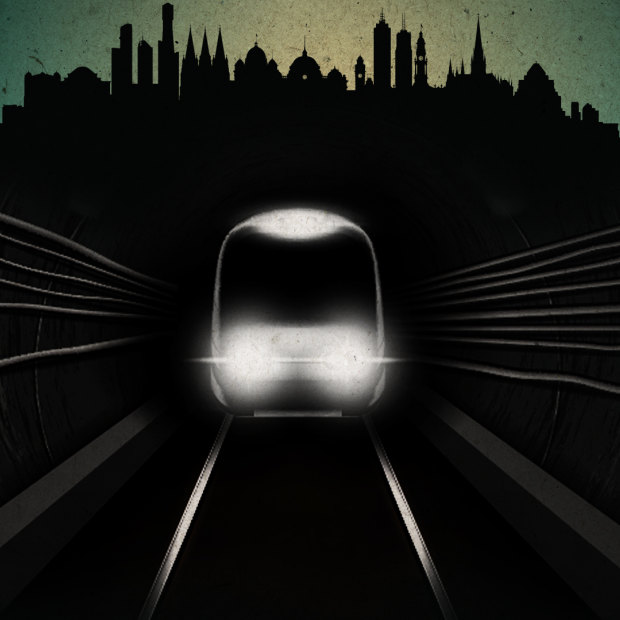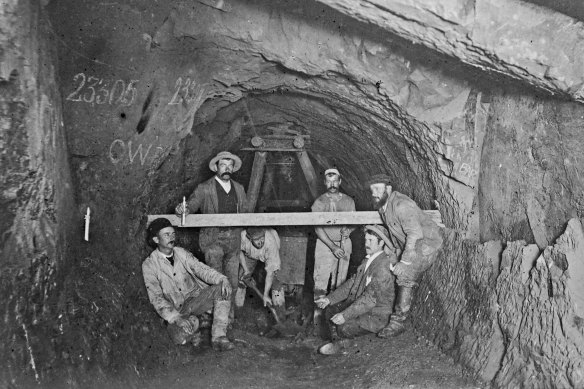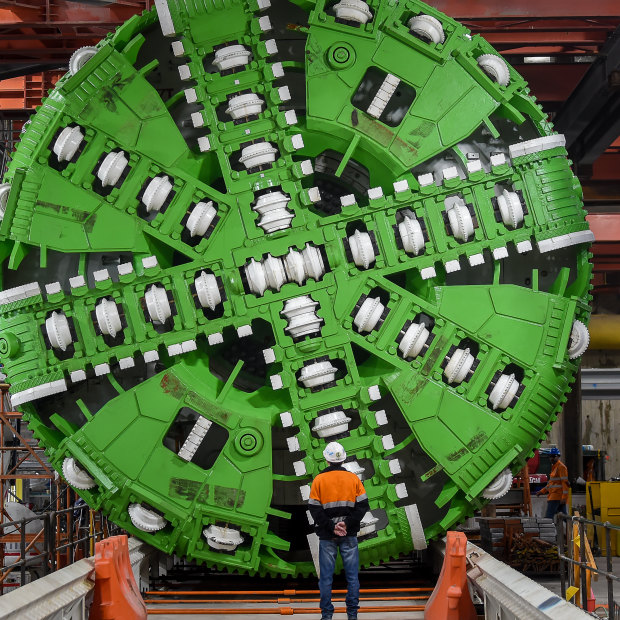Behind the scenes of the CBD’s biggest underground project

By Patrick Hatch
Track testing on the Metro Tunnel will begin later this year.Credit: Illustration: Marija Ercegovac
Save articles for later
Add articles to your saved list and come back to them any time.
Melbourne’s city centre has changed dramatically over the past six years as a construction blitz altered the streetscape and added towering new buildings to the skyline.
But there’s been just as much going on beneath our feet, out of sight.
Two tunnels – each a touch larger than the body of an A380 superjumbo jet – have been bored nine kilometres from South Kensington, under Parkville and the length of Swanston Street to South Yarra.
Trains will roll through these tunnels for the first time later this year when track testing begins on the new underground train line, which is expected to carry 12,000 commuters a day when it opens in 2025.
The Age’s Underground Melbourne series is exploring what lies beneath our city. And the Metro Tunnel is the CBD’s biggest subterranean development since the first sod was turned on the original City Loop half a century ago.
Construction work has caused significant disruption, closing some streets since 2017 and driving customers away from nearby traders.
But Metro Tunnel project director Linda Cantan says limiting disruption to the city while building something this big was one of her team’s biggest achievements.
Five new stations
“We’re essentially walking down on Swanston Street at the moment with the trams above us, and they’re all blissfully ignorant to everything that’s going on,” she says during a tour of the Town Hall Station site, one of five new underground stations being built.
A concrete shed erected at the site to limit noise and dust was removed in January, leaving a giant hole plunging 27 metres (or eight storeys) into the ground next to St Paul’s Cathedral.
A roof will eventually be installed, but Cantan says the station had been designed to retain its striking cavernous qualities.
“We spent so much time and energy on this grand space, you then want to highlight it and make it a feature of the station,” she says.
The original City Loop had a far more visible impact when it was built. Museum Station (now called Melbourne Central) was dug out as a 168-metre-long exposed crater, which forced La Trobe Street trams and traffic to be rerouted for almost five years.
Construction of Town Hall and the Metro Tunnel’s other CBD station, State Library, has been more like keyhole surgery; entering via a smaller entry shaft and then mining under the city.
It hasn’t been without controversy, though. The Oxford Scholar pub on Swanston Street was one business to shut in 2017 when construction work and dust drove away punters (it’s since reopened), and traders were evicted from the heritage-listed underground Campbell Arcade last April to make way for a walkway between Flinders Street Station and Town Hall Station.
The Port Phillip Arcade off Flinders Street was also demolished, with traders evicted, and others on the adjoining Scott Alley experiencing a drop in customers. Alpha Barbers owner Frank Bazzano’s turnover dipped by around 30 per cent in 2017 as construction began.
“It was a bit hairy at the start. It was excruciating noise – not the nicest place to come to get a haircut, when all you can hear is a bomb going off every two seconds,” Bazzano says.
But he says business has since recovered to pre-tunnel (and pre-COVID) levels, and traders in the area are now feeling upbeat about the new station opening on their doorstep.
An underground rail line was first proposed in the 1920s, but construction on what was then called the Melbourne Underground Railway Loop didn’t start until 1971.
City Loop decades in the making
With four separate tunnels each 3.7 kilometres long, it was 10 years before Museum Station (Melbourne Central) opened, and 14 years before the project was completed.
The timeline for the Metro Tunnel is shorter – it is expected to be finished in eight years. Jim Heron, the project’s construction director, said improvements to tunnel boring machines had made the job far easier than when the City Loop was built.
Four machines – each 7.3 metres across and 120 metres long – started burrowing along the route like massive mechanical worms in mid-2019, with their rotating heads grinding through 10 metres of earth every day.
By the time they finished in May 2021, the machines had removed 600,000 cubic metres of rock and soil for under the city – enough dirt to fill the MCG to the brim.
Modern technology is powering this megaproject, but it was all very different when the first major dig under Melbourne began in 1892 – work on the city’s sewerage system.
Sydney started building its sewers in 1854 and Adelaide finished theirs in 1885. But in Melbourne people still tipped their excrement into open street channels leading to the Yarra.
The rampant spread of typhoid and cholera – not to mention being labelled “Marvellous Smelbourne” – made building a sewerage system the most pressing issue of the day.
Melbourne’s sewerage system was built in the 1890s.
Even by today’s standards it was a megaproject: 2000 labourers dug 56 kilometres of main sewers stretching from the Spotswood Pumping Station under the Yarra to Port Melbourne and under the Maribyrnong River to the northern suburbs. They lined them with 25,000 tonnes of cement and close to 20 million bricks. Another 435 kilometres of pipes extended into individual properties.
Six workers drowned on April 12, 1895 when the tunnel they were digging under the Yarra River at Spotswood was flooded. Twelve died working on the project in total – a figure considered a good safety record at the time.
The All England Eleven Hotel, which previously stood at the corner of Rouse and Princes streets in Port Melbourne, was the first property to be connected, on August 17, 1897. Most of the original sewer network is still being used today.
Difficult terrain
Heron says Melbourne is a difficult place to dig, with its inconsistent geology keeping engineers on their toes.
The CBD sits atop the so-called Dargile Formation, which is made of interbedded marine mudstone and sandstone laid down during the Silurian period (about 425 million years ago), with the western half covered by a thin capping of basalt lava and sandstone around 25 to 5 million years ago.
The Metro Tunnel had to drive through clay near the Domain, hard basalt while dipping under the Yarra, and then into the dreaded Coode Island Silt past Parkville, towards Arden and the tunnel exit at Kensington.
Alice, the tunnel boring machine.Credit: Justin McManus
“So we’re hitting some hard stuff, some soft stuff, some Coode Island Silt – it’s pretty rubbish material,” he says.
The Metro Tunnel dives as deep as 40 metres below ground level, so it avoided existing infrastructure and could dip under both the Yarra River and the City Loop near the State Library station.
Herson says there is always a degree of uncertainty when digging underground, and close monitoring of buildings at the surface was needed to check the tunnel wasn’t causing unexpected damage.
“You can do as much investigation as you want… but you may miss picking up the material that you never envisioned being there,” he explains. “So there’s always nervousness.”
The Morning Edition newsletter is our guide to the day’s most important and interesting stories, analysis and insights. Sign up here.
Most Viewed in National
Source: Read Full Article



